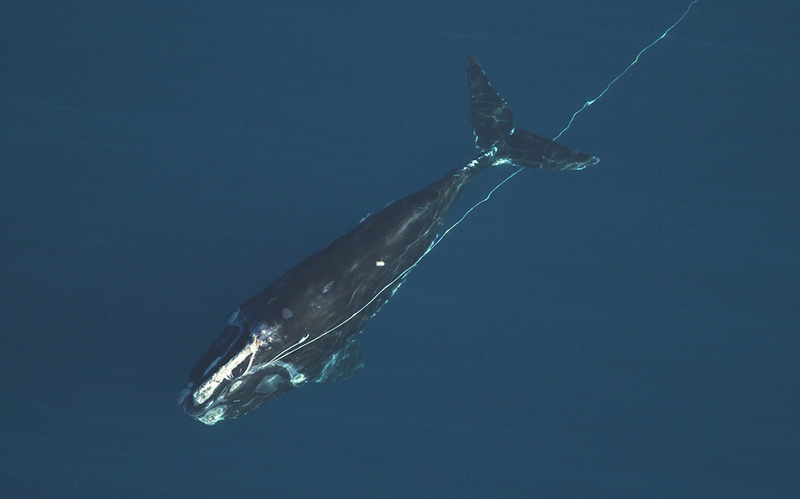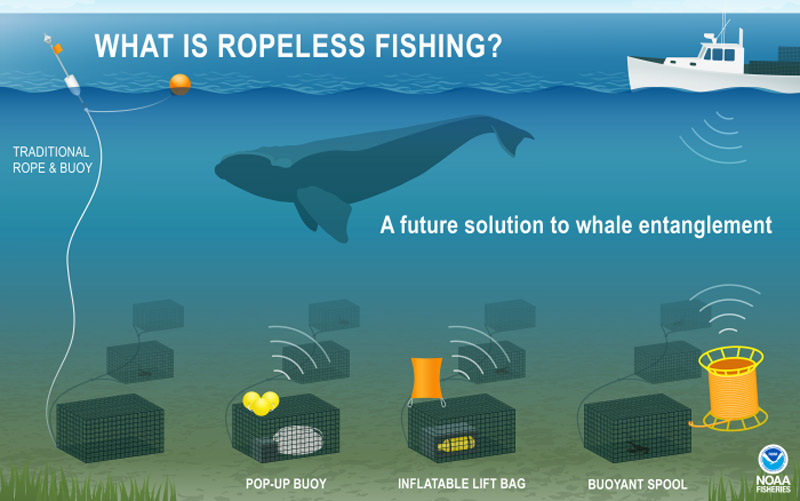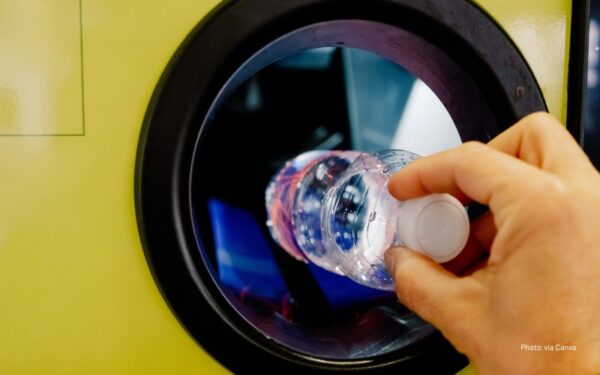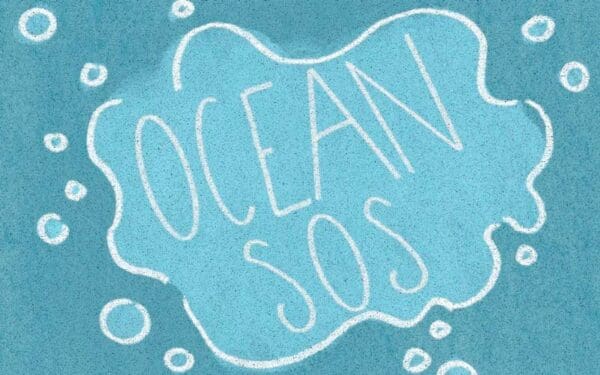
Entanglements in fishing gear threaten the survival of critically endangered North Atlantic right whales. Ropeless fishing gear can reduce that risk. Photo: Florida Fish and Wildlife Conservation Commission taken under NOAA research permit 15488/CC-BY-NC-ND-2.0
A colorful bobbing buoy is an iconic part of New England’s visual identity, a symbol of fresh-caught seafood and days spent by the water. But all those buoys can pose a danger to marine life. The thick vertical lines that connect buoys to lobster traps on the seafloor can entangle whales, causing grievous injuries and slow, painful deaths. Ropeless fishing gear offers a solution that can protect whales and preserve a way of life for New England fishermen.
Ropeless fishing gear is a catch-all term that includes pop-up, buoyless, and on-demand fishing systems. These gear systems are an exciting innovation that reduces the risk of deadly entanglements for critically endangered North Atlantic right whales, who spend much of the year in New England waters. Making ropeless gear safe, accessible, and affordable to fishermen is key to ensuring its wide adoption.
Fishing with Vertical Lines Endangers Right Whales
With fewer than 350 North Atlantic right whales left on the planet, the species is one step away from extinction, according to the International Union for Conservation of Nature. Humans pose the biggest threat to their survival due to entanglements with fishing gear and collisions with ships and boats.
Conventional fishing practices use thick vertical lines to connect buoys to traps on the seafloor. More than three million lobster traps are spread throughout New England’s waters, creating a dangerous maze for right whales to navigate during their annual migration from the southern U.S. to Canada. At least 85% of right whales have been entangled in fishing gear once in their lifetime.
Getting entangled in that vertical line can cause severe injuries and even death, partly because modern fishing line is woven with synthetic materials that don’t deteriorate over time. Whales can remain painfully entangled for months or more, dragging heavy gear behind them for hundreds or even thousands of miles. The fishing rope can impede a whale’s ability to feed and swim, putting it at risk of slowly starving to death if rescuers cannot free the whale from the rope in time. Whales that survive entanglement carry permanent scars of their ordeal.
Currently, the most effective way to reduce the risk of entanglement is to close areas where whales congregate to commercial fishing. With ropeless fishing gear, people can continue to set traps without the risk of whales getting caught in their equipment.
How Ropeless Fishing Gear Works
The technology to retrieve equipment off the ocean floor has been around for decades. A range of ropeless gear technology in development promises a solid alternative to vertical lines in the water.
Here’s how ropeless fishing gear works in lobster or crab fisheries like the ones we have in New England:
- Traps are released from the boat down to the ocean floor.
- When it’s time to retrieve the traps, fishing crews send an acoustic signal from a transducer on their boat to a release mechanism attached to the first trap or string of traps (called a trawl).
- Depending on the type of system, either a pop-up buoy, inflatable lift bag, or buoyant spool of rope floats to the surface.
- From here, the crew can haul traps onto their boats.

New England Fishing Crews are Testing Ropeless Fishing Gear
For ropeless fishing gear to gain acceptance across the industry, it must work safely and efficiently for the people who depend on it. CLF has been working in partnership with researchers, engineers, lobstermen, and other conservationists to test the gear on the water in real-world conditions. After three years, lobstermen have successfully deployed and hauled thousands of traps from the water.
But additional trials are needed to confirm the gear’s safety in all types of weather, currents, and distances from shore. We also need to ensure that the transition to ropeless fishing gear makes financial sense for the fishing industry. While the price of ropeless gear systems will come down through competition between manufacturers and economies of scale, the financial support of federal and state governments is needed in the meantime.
The Truth: Ropeless Fishing Gear Can Create a Safer Ocean
Fishing is essential to New England’s heritage – and to its future. Right whales are, too. Ropeless fishing gear provides an innovative way forward that will give right whales a fighting chance for survival and allow our region’s iconic lobstermen and -women to continue to thrive. By reducing the number of vertical lines in the water, we can clear miles of ocean for right whales to swim without the threat of deadly entanglement.
It’s possible to shift to ropeless fishing gear in areas where it poses a high risk to right whales and other wildlife. But making this transition requires more federal funding, additional technological innovations, training, and continued collaboration with the lobster industry and other stakeholders.
The investment is worth it. Ropeless fishing gear is the way forward to keep both right whales and New England’s fishing traditions alive.



